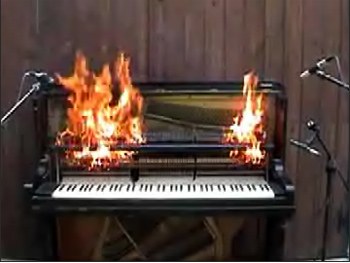Extreme sampling: 11 ways to create unique sounds
It’s not just instruments that you can record…

Most of us have the tools required to record any sound in any place - even a mobile phone can be used to capture audio - but still we persist in filling our music with conventional material that everyone's heard before. And what of all those plug-ins you have in your arsenal - do you really use them to their full potential?
If you want to make your music really stand out, one of the best things you can do is create sounds that are truly your own. MusicRadar has 11 ways that you can go about doing it…
1. Capture real life
Leave a mini-cassette recorder somewhere and let it record until the tape runs out, then play it back. You might find that not knowing what you're listening to enables you to hear familiar surroundings in a new context. Just don't use recordings of people talking without their permission!
2. That's degrading
Degradation can be your friend. Interesting things can happen when you leave your machines to their own devices. Allow the batteries of a cassette player to run low and re-record the results, or copy and re-copy a recording until it degrades.
3. Dial it in
Shortwave radios and AM receivers can be a goldmine for bizarre sounds. You can't use the copyright broadcasts beamed over the airwaves, but the spaces between the stations can provide an infinite variety of hisses, squeals, squeaks and noises. Try vocoding some random knob twisting, using a drum track as the modulator.
4. Follow through
Envelope followers detect the dynamics of an incoming signal and apply them to another signal. Try using one to impart definition to a sound with no discernible envelope. For example, wrap the envelope of a piano note around the sustained hum of an industrial machine.
5. Morphology
Many additive synths enable you to resynthesize sounds and morph them into other sounds. Make use of this technique to pitch a sound or reshape it into something completely new. Try creating hybrids of pitched musical sounds and un-pitched found sounds.
Want all the hottest music and gear news, reviews, deals, features and more, direct to your inbox? Sign up here.
6. Elemental audio
Take a cue from Spectrasonics' Omnisphere and apply the elements of air, earth, wind and fire to your recording processes. While your gran might not take too kindly to you setting the family piano ablaze, you can still try recording it through an electric fan, or using a microphone buried under an inch of soil, for example.
7. Freezer burn
Heat causes things to expand, and cold makes them contract. Use this to your advantage by exposing musical devices to extreme temperatures and recording the effects. One guy we know got some amazing sounds by sticking musical boxes in the freezer and recording them as they thawed out.
8. Hydro power
It's one of the oldest tricks in the book: fill a few glasses, cans or bottles with varying amounts of liquid and bang, tap and smack 'em with sticks. The pitch will vary depending on the amount of liquid each one contains - this technique works particularly well with big metal drums!
9. Shake rattle and roll
Find a second-hand kick drum or floor tom, cut out a bit of screen mesh and stretch it over the bottom head (not the batter head). Fill the space between with marbles, ball bearings and/or loose chains and set about it with a big stick.
10. String thing
If it's got a string, it can be tuned. Buy some bass, guitar or violin strings and strap them across any hollow object you can attach them to. Cut or wrap them to different lengths to tune them as needed. Pick, pluck or bow them. Use them acoustically or amp them up.
11. Blow hard
Any hollow tube can be made into a reed instrument. There are lots of resources online that will show you the spacings required for specific pitches. Drill some holes and pucker up!
Computer Music magazine is the world’s best selling publication dedicated solely to making great music with your Mac or PC computer. Each issue it brings its lucky readers the best in cutting-edge tutorials, need-to-know, expert software reviews and even all the tools you actually need to make great music today, courtesy of our legendary CM Plugin Suite.
